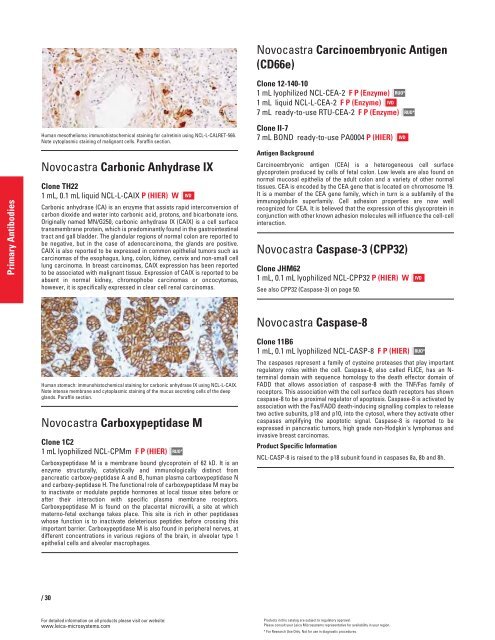QF0159 Marketing Release Record
QF0159 Marketing Release Record
QF0159 Marketing Release Record
You also want an ePaper? Increase the reach of your titles
YUMPU automatically turns print PDFs into web optimized ePapers that Google loves.
Primary Antibodies<br />
Human mesothelioma: immunohistochemical staining for calretinin using NCL-L-CALRET-566.<br />
Note cytoplasmic staining of malignant cells. Paraffin section.<br />
Novocastra Carbonic Anhydrase IX<br />
Clone TH22<br />
1 mL, 0.1 mL liquid NCL-L-CAIX P (HIER) W<br />
Carbonic anhydrase (CA) is an enzyme that assists rapid interconversion of<br />
carbon dioxide and water into carbonic acid, protons, and bicarbonate ions.<br />
Originally named MN/G250, carbonic anhydrase IX (CAIX) is a cell surface<br />
transmembrane protein, which is predominantly found in the gastrointestinal<br />
tract and gall bladder. The glandular regions of normal colon are reported to<br />
be negative, but in the case of adenocarcinoma, the glands are positive.<br />
CAIX is also reported to be expressed in common epithelial tumors such as<br />
carcinomas of the esophagus, lung, colon, kidney, cervix and non-small cell<br />
lung carcinoma. In breast carcinomas, CAIX expression has been reported<br />
to be associated with malignant tissue. Expression of CAIX is reported to be<br />
absent in normal kidney, chromophobe carcinomas or oncocytomas,<br />
however, it is specifically expressed in clear cell renal carcinomas.<br />
Human stomach: immunohistochemical staining for carbonic anhydrase IX using NCL-L-CAIX.<br />
Note intense membrane and cytoplasmic staining of the mucus secreting cells of the deep<br />
glands. Paraffin section.<br />
Novocastra Carboxypeptidase M<br />
Clone 1C2<br />
1 mL lyophilized NCL-CPMm F P (HIER)<br />
Carboxypeptidase M is a membrane bound glycoprotein of 62 kD. It is an<br />
enzyme structurally, catalytically and immunologically distinct from<br />
pancreatic carboxy-peptidase A and B, human plasma carboxypeptidase N<br />
and carboxy-peptidase H. The functional role of carboxypeptidase M may be<br />
to inactivate or modulate peptide hormones at local tissue sites before or<br />
after their interaction with specific plasma membrane receptors.<br />
Carboxypeptidase M is found on the placental microvilli, a site at which<br />
materno-fetal exchange takes place. This site is rich in other peptidases<br />
whose function is to inactivate deleterious peptides before crossing this<br />
important barrier. Carboxypeptidase M is also found in peripheral nerves, at<br />
different concentrations in various regions of the brain, in alveolar type 1<br />
epithelial cells and alveolar macrophages.<br />
/30<br />
For detailed information on all products please visit our website:<br />
www.leica-microsystems.com<br />
RUO*<br />
IVD<br />
Novocastra Carcinoembryonic Antigen<br />
(CD66e)<br />
Clone 12-140-10<br />
1 mL lyophilized NCL-CEA-2 F P (Enzyme)<br />
1 mL liquid NCL-L-CEA-2 F P (Enzyme) IVD<br />
7 mL ready-to-use RTU-CEA-2 F P (Enzyme)<br />
Clone II-7<br />
7 mL BOND ready-to-use PA0004 P (HIER)<br />
Antigen Background<br />
Carcinoembryonic antigen (CEA) is a heterogeneous cell surface<br />
glycoprotein produced by cells of fetal colon. Low levels are also found on<br />
normal mucosal epithelia of the adult colon and a variety of other normal<br />
tissues. CEA is encoded by the CEA gene that is located on chromosome 19.<br />
It is a member of the CEA gene family, which in turn is a subfamily of the<br />
immunoglobulin superfamily. Cell adhesion properties are now well<br />
recognized for CEA. It is believed that the expression of this glycoprotein in<br />
conjunction with other known adhesion molecules will influence the cell-cell<br />
interaction.<br />
Novocastra Caspase-3 (CPP32)<br />
Clone JHM62<br />
1 mL, 0.1 mL lyophilized NCL-CPP32 P (HIER) W<br />
See also CPP32 (Caspase-3) on page 50.<br />
Novocastra Caspase-8<br />
Clone 11B6<br />
1 mL, 0.1 mL lyophilized NCL-CASP-8 F P (HIER)<br />
The caspases represent a family of cysteine proteases that play important<br />
regulatory roles within the cell. Caspase-8, also called FLICE, has an Nterminal<br />
domain with sequence homology to the death effector domain of<br />
FADD that allows association of caspase-8 with the TNF/Fas family of<br />
receptors. This association with the cell surface death receptors has shown<br />
caspase-8 to be a proximal regulator of apoptosis. Caspase-8 is activated by<br />
association with the Fas/FADD death-inducing signalling complex to release<br />
two active subunits, p18 and p10, into the cytosol, where they activate other<br />
caspases amplifying the apoptotic signal. Caspase-8 is reported to be<br />
expressed in pancreatic tumors, high grade non-Hodgkin's lymphomas and<br />
invasive breast carcinomas.<br />
Product Specific Information<br />
NCL-CASP-8 is raised to the p18 subunit found in caspases 8a, 8b and 8h.<br />
Products in this catalog are subject to regulatory approval.<br />
Please consult your Leica Microsystems representative for availability in your region.<br />
* For Research Use Only. Not for use in diagnostic procedures.<br />
RUO*<br />
IVD<br />
RUO*<br />
IVD<br />
RUO*
















